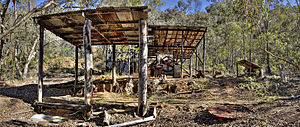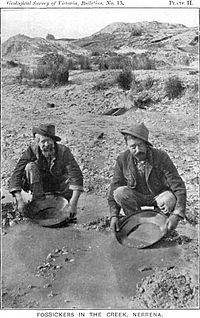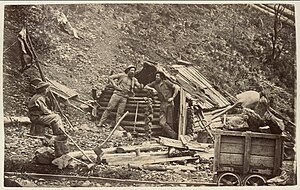AY Honors/Gold Prospecting/Answer Key
The Victorian gold rush was a period in the history of Victoria, Australia approximately between 1851 and the late 1860s. In 10 years the Australian population nearly tripled.&
During this era Victoria dominated the world's gold output. Ballarat for a while ranked number one in terms of gold production.&
Gold discoveries in Beechworth, Ballarat and Bendigo sparked gold rushes similar to those of California in 1849. & At its peak some two tonnes of gold per week flowed into the Treasury Building in Melbourne.
The gold era evolved Victoria from a sheep grazing economy based around squatters, into an emerging industrial base and small (yeoman) farming community. The social impact of gold was that Victoria's population boomed and the lack of available land for small farming generated massive social tensions. Those on-going tensions around land and selection (small farming) culminated in the Kelly Outbreak of 1878. &
It was gold that created the growth and power of Melbourne over its rivals; this is witnessed in the rail networks radiating out of Melbourne to its regional towns and ports. Politically, Victoria's goldminers introduced male franchise and secret ballots, based on Chartist principles. As gold dwindled, pressures for land reform, protectionism and political reform grew and generated social struggles. & & A Land Convention in Melbourne during 1857 demanded land reform. Melbourne, or "Smellbourne" (due to the stench of the tanneries along the river) became one of the great cities of the British Empire and the world. Following the huge gold rushes were the Chinese in 1854. Their presence on the goldfields of Bendigo, Beechworth and the Bright district resulted in riots, entry taxes, killings and segregation in the short term and became the foundations of the White Australia policy. & In short, the gold rush was a revolutionary event and reshaped Victoria, its society and politics.
Background
By 1840 the city of Melbourne, in the south of Victoria, was nearly five years old. Population growth in Melbourne and the surrounding countryside had been steady, and the population was around 10,000.
In July 1851, Melbourne's 29,000 residents celebrated as they broke away from New South Wales and the Colony of Victoria was born. Weeks later gold was found in Victoria. The discovery by Louis Michel, and William McKay Aberdeen at Anderson's Creek, near Warrandyte 30 kilometres north-east of Melbourne was awarded a prize by the new Victorian Government, with other discoveries by James Esmond at Clunes in July 1851, and Thomas Hiscock at Buninyong, near Ballarat, on 2 August 1851.
On 20 July 1851 Thomas Peters, a hut-keeper on William Barker’s Mount Alexander station, found specks of gold at what is now known as Specimen Gully. This find was published in the Melbourne Argus on 8 September 1851, leading to a rush to the Mount Alexander or Forest Creek diggings, centred on present-day Castlemaine, claimed as the richest shallow alluvial goldfield in the world.
These discoveries were soon surpassed by Ballarat and Bendigo. Further discoveries including Beechworth in 1852, Bright, Omeo, Chiltern, Victoria (1858–59) and Walhalla followed.
| Year | Population of Melbourne (not including the Aboriginal Population |
|---|---|
| 1835 | 0 |
| 1840 | 10,000 |
| 1851 | 29,000 |
| 1854 | 123,000 |
The population of Melbourne grew swiftly as the gold fever took hold. The total number of people in Victoria also rose. By 1851 it was 75,000 people. Ten years later this rose to over 500,000.
First obtained was the alluvial gold found on the surface. It is reported that miners when first arrived on the Mount Tarrengower fields nuggets were picked up without digging. This was followed by exploitation of alluvial gold usually in creeks and rivers. The seekers used gold pans, puddling boxes and cradles to separate this gold from the dirt and water.
As alluvial gold ran out, underground or deep lead mining began. This was harder and dangerous. Locales such as Bendigo and Ballarat saw great concentrations of miners as teams and syndicates sank shafts. Coupled with erratic and vexatious policing and licence checks, tensions flared around Beechworth Bendigo and Ballarat. These tensions culminated in the Eureka Rebellion of 1854. Following the rebellion, a range of reforms gave miners a greater democratic say in resolving disputes via Mining Courts and an extended electoral franchise.
At Walhalla alone, Cohens Reef produced over 50 tonnes (1.6 million tr oz) of gold in 40 years of mining.
Major and long lasting impact
Australia's population changed dramatically as a result of the rushes. In 1851 the Australian population was 437,655, of which 77,345, or just under 18%, were Victorians. A decade later the Australian population had grown to 1,151,947 and the Victorian population had increased to 538,628; just under 47% of the Australian total and a seven-fold increase. In some small country towns where gold was found aboundant, the population could grow of over 1000% in a decade (e.g. Rutherglen had a population of ~2'000. Ten years later, it had ~60'000 which is a 3000% increase). The rapid growth was predominantly a result of the gold rushes.&
The gold rush is reflected in the architecture of Victorian gold-boom cities like Melbourne, Castlemaine, Ballarat, Bendigo and Ararat. Ballarat has Sovereign Hill — a 60 acre (240,000 m²) recreation of a gold rush town — as well as the Gold Museum, while Bendigo has a large operating gold mine system which also functions as a tourist attraction.
The rushes left the legacy of quaint Victorian towns in the Goldfields tourist region like Maldon, Beechworth, Clunes, Heathcote, Victoria, Maryborough, Daylesford, Stawell, Beaufort, Creswick, St Arnaud, Dunolly, Inglewood and Buninyong. With the exception of Ballarat and Bendigo, many of these towns were substantially larger than they are today. Most populations moved to other districts when gold played out in a given locality. &
At the other end of the spectrum ghost towns, such as Walhalla, Mafeking and Steiglitz still exist.

The last major gold rush in Victoria was at Berringa, south of Ballarat, in the first decade of the 20th century. Gold mining ceased in Victoria, not because there was no more gold but in part because of the depth and cost of pumping. The First World War also drained Australia of the labour needed to work the mines, but worse the prohibition on the export of gold from Australia in 1915, the abolition of the gold standard throughout the Empire, saw many goldtowns in Victoria die.&. The slump in gold production never recovered. However, as of 2005 the recent increase in the gold price has seen a resurgence in commercial mining activity; mining has yet to be resumed in Bendigo, whilst some is occurring in Ballarat, and exploration proceeds elsewhere, for example, in Glen Wills, an isolated mountain area near Mitta Mitta in north-eastern Victoria.
See also
References
- ↑ California Gold Rush. Robert Whaples, Wake Forest University.
- ↑ Weston Bate, Lucky City: The first generation of Ballarat, 1851-1901( 1978)
- ↑ David Goodman, Gold Seeking: Victoria and Calfornia in the 1850s (1994)
- ↑ John McQuilton, The Kelly Outbreak 1878-1880; The geographical dimensions of social banditry (1979)
- ↑ Antony O'Brien, Shenanigans on the Ovens Goldfields
- ↑ I.D. McNaughton, 'Colonial Liberalism, 1851-92', in Gordon Greenwood (ed.) Australia: A social and political history (1955)
- ↑ Katherine Cronin, Colonial Casualties: Chinese in Early Victoria (1982); and Cf O'Brien, Ch. 3.
- ↑ Caldwell, J. C. (1987). "Chapter 2: Population". In Wray Vamplew (ed.). Australians: Historical Statistics. Broadway, New South Wales, Australia: Fairfax, Syme & Weldon Associates. pp. 23 and 26. Template:Hide in printTemplate:Only in print.
- ↑ O'Brien
- ↑ Marnie Hague-Muir, "The economy at war" ,Joan Beaumont (ed.) Australia's War 1914-18
Further reading
- Robyn Annear,Nothing but Gold Robyn Annear ISBN 1-876485-07-8
- G.F. James & C.G. Lee,Walhalla Heyday G.F. James & C.G. Lee ISBN 0-9596311-3-5
- John Aldersea & Barbara Hood,Walhalla: Valley of Gold John Aldersea & Barbara Hood ISBN 0-9750887-0-X
- James Flett, The history of gold discovery in Victoria,, 1970.
- Vivine McWaters, Beechworth's little canton, 2002.
- Geoffrey Serle, The Golden Age: A history of the colony of Victoria, 1851-1861, 1963.
- Carole Woods, Beechworth: A titan's field, 1985.
- John Maloney, Eureka, 1984.
- Dianne Talbot, The Buckland Valley Goldfield, 2004.
- Frank Cusack (ed.), Songs of the goldfields, 1991.


